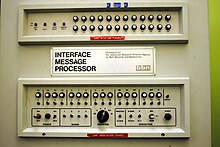Interface message processor
An Interface Message Processor ( IMP ) is a packet switching node for the ARPANET and the immediate forerunner of modern routers . IMPs are a subject of the first Request for Comments from April 1969, RFC 1 .
IMPs are based on minicomputers of the series 16 from Honeywell . First, Honeywell DDP-516 were used in a particularly robust design, later Honeywell H316 . The IMPs communicated with the hosts via special high-speed serial interfaces and connected them to the ARPANET.
The IMP was invented by Wesley A. Clark, who was then working at Washington University in St. Louis . He proposed the concept in April 1967 at a conference hosted by Lawrence Roberts , head of the ARPANET project. Until then, it was planned to develop software for each operating system to be networked, which was supposed to make all of them interoperable . Clark suggested defining an interface that was as easy to implement for all systems as possible, and implementing the interface to the external network separately for those systems that could mediate between the others. This concept became an essential foundation of the later Internet .
In June 1968, Roberts and his colleague Barry Wessler wrote the final specification of the IMP on the basis of a study that has meanwhile been carried out by the Stanford Research Institute .
In December 1968, Bolt Beranek and Newman (BBN) received the order for the first implementations . The composition of the team that implemented the first IMP was:
- Head: Frank Heart
- Software: Bernie Cosell, William Crowther , Robert E. Kahn , Hawley Rising, Dave Walden
- Hardware: Ben Barker, Severo Ornstein, Marty Thrope
- unknown assignment: Bill Bertell (Honeywell), Jim Geisman, Truett Thach
The first IMP was at the University of California, Los Angeles . It was connected to a Sigma 7 from Scientific Data Systems . The second IMP was set up at the Stanford Research Institute (SRI) and connected to an SDS 940. The first communication took place on October 29, 1969 under the direction of Leonard Kleinrock . It was the first two letters of the word " login ". The system crashed when the third letter was sent. An hour later, the error-free transmission succeeded.
literature
- Bolt Beranek and Newman Inc .: Report No. 1822. Interface Message Processor. Specifications for the Interconnection of a Host and an IMP . Internet Standard 39 ( PDF; 8.4 MB ).
- Bernd W. Wirtz: Gabler Compact Lexicon eBusiness. Publishing house Dr. Th. Gabler GmbH, Wiesbaden 2002, ISBN 978-3-409-11800-2 .
- Rick Graziani, Allan Johnson: Routing Protocols and Concepts. Addison-Wesley Verlag, Munich 2009, ISBN 978-3-8273-2719-2 .
- Johann Blieberger, Johann Klasek, Alexander Redlein, Gerhard-Helge Schildt: Computer science. 3rd expanded edition, Springer Verlag, Vienna 1996, ISBN 978-3-211-82860-1 .
- James F. Kurose, Keith W. Ross: Computer Networks. 4th updated edition, Pearson Education, Munich 2008, ISBN 978-3-8273-7330-4 .
supporting documents
- ^ IMP - Interface Message Processor . Retrieved May 16, 2009.
- ^ Leonard Kleinrock: The Day the Infant Internet Uttered its First Words . Retrieved April 13, 2016.
- ↑ Request to Move STD 39 to Historic Status . Internet Engineering Task Force. Retrieved April 18, 2009.
Web links
- The interface message processor for the ARPA computer network (accessed July 24, 2017)
- The ARPANET Interface Message Processor (IMP) Port Expander (PE) (accessed July 24, 2017)
